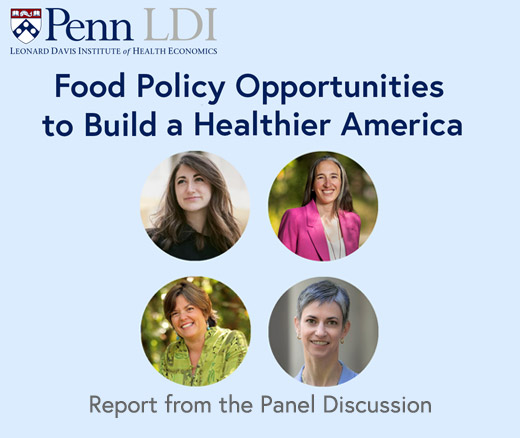
Contradictions That Confuse Federal Food Policies
Announcing Bold New Goals While Crippling the Infrastructure Needed to Achieve Them
Population Health
Blog Post

A child’s health depends on proper nutrition. As Food is Medicine initiatives expand across the country, community-based clinics face the challenge of designing programs that can best serve their patients.
A recent study by LDI Senior Fellows Aditi Vasan, Senbagam Virudachalam, Chén Kenyon, and Alexander Fiks sought to understand caregiver preferences for food assistance programs.
Their finding was simple: Caregivers prefer food programs that provide delivery services, give them the ability to make choices for their family, and provide support from a benefits enrollment specialist, community health worker, or social worker rather than a nurse or doctor. To understand more about how to deliver effective food assistance to families, and the need for culturally-tailored programs, we talked with Dr. Aditi Vasan:
Vasan: The American Academy of Pediatrics recommends that pediatricians routinely screen families for food insecurity and connect them with available and appropriate community resources. In response, pediatric hospitals and clinics have developed many different types of food assistance programs. I was interested in understanding how different types of food assistance programs might be perceived by caregivers. Our goal was to understand caregiver preferences that could guide hospitals and clinics in deciding which types of food assistance programs they should invest in.
Vasan: I have cared for many patients and families experiencing food insecurity, and I have found that the resources we had available for them in clinical settings did not always align with their needs and preferences. For example, I’ve cared for families who experienced stigma and discrimination when using food banks or food pantries, or had concerns about food quality in these settings. I have also cared for some families who really wanted to receive food in person in clinical settings and other families who preferred food delivered to their homes. I wanted to try to understand and characterize families’ preferences systematically.
Vasan: We focused on caregivers of children under five because they are at particularly high risk of adverse health and developmental effects of food insecurity. We expect that preferences might differ for caregivers of older children, particularly children who qualify for school-based meals, because their overall levels of food insecurity and preferences for supplemental resources may differ.
Vasan: One example is a nonprofit hospital or clinic using their community benefit spending to partner with a local community-based organization (CBO) that provides home produce or prepared meal delivery. These partnerships could both benefit hospitals, by allowing them to address food insecurity among patients and families, and CBOs, by expanding their population of families served. Medical-financial partnerships between clinics and financial service CBOs could also help support families experiencing food insecurity. For example, these partnerships provide families with financial counseling and help connect them to nutrition benefits and/or tax preparation services that increase the income they have available to purchase food.
Vasan: We didn’t include cost, but we know that cost is one of the key factors that pediatric hospitals and clinics have to consider when making real-world decisions about what kinds of food resources to incorporate. We think these decisions should ideally be guided both by cost information and families’ preferences, and we encourage clinics to use partnerships with CBOs and referrals to government benefit programs to provide families with different kinds of support. For example, it may not be feasible for all clinics to develop and fund their own food delivery programs, but clinics could enroll families in the Supplemental Nutrition Assistance Program (SNAP), which allows for online ordering and food delivery.
Vasan: Pediatric clinics should incorporate referrals to food resources that align with families’ preferences, in partnership with community-based organizations. This could include providing warm handoffs to CBOs that provide home food delivery or using a medical-financial partnership to help families enroll in Special Supplemental Nutrition Program for Women, Infants, and Children (WIC) and SNAP. We also recommend that clinics consider a tiered approach to resource referrals, targeting more intensive resources like meal delivery programs to families with more complex medical and social needs, while making less intensive resources like information about food banks and food pantries available to all patients.
For policymakers, our findings underscore the importance of developing payment models that can sustainably fund nutrition support. For example, several states are piloting Medicaid coverage for food and nutrition support programs through Section 1115 waivers focused on addressing health-related social needs. Payers and policymakers should also consider the importance of reimbursing for team-based care, including support for community health worker services to help families connect with resources.
Vasan: We know that food insecurity is one of the most prevalent and pressing social needs for children and families living in poverty, and we see this as a particularly important area for social needs screening and support interventions, particularly since families might not be aware of the food resources that exist at their clinics and in their communities. Ultimately, food assistance programs should be one component of the web of support families receive to address social determinants of health and unmet social needs. And it’s important to consider families’ other social needs and their children’s medical needs when determining what kinds of food and nutrition support programs may be most appropriate for them. One ongoing area of research within our team is looking at directed food assistance programs (e.g., SNAP or WIC benefits) and non-directed cash transfer programs (e.g., the expanded Child Tax Credit) that families can use to purchase food. We see a need for ongoing research in this space to help elucidate what kinds of assistance programs are likely to be most beneficial for families.
The study, “Caregiver Preferences for Primary Care Clinic-Based Food Assistance: A Discrete Choice Experiment,” was published on February 23, 2024 in Academic Pediatrics. Authors include Aditi Vasan, DanaRose Negro, Mishaal Yazdani, Lindsay Benitez, Senbagam Virudachalam, Chén Kenyon, and Alexander Fiks.


Announcing Bold New Goals While Crippling the Infrastructure Needed to Achieve Them

Promising New Evidence and What’s Next

From 1990 to 2019, Black Life Expectancy Rose Most in Major Metros and the Northeast—but Gains Stalled or Reversed in Rural Areas and the Midwest, Especially for Younger Adults

A Penn LDI Seminar Focuses on Why They’re Important for the Future

Former Philadelphia Health Commissioner Warns That Gutting the CDC, Undermining Vaccines, and Politicizing Science Will Leave the U.S. Dangerously Unprepared for the Next Pandemic

Rural Parents Had More Emergency Visits and Insurance Loss Than Urban Peers, an LDI Study Shows. Integrated Baby Visits Could Help All Parents Be Healthier